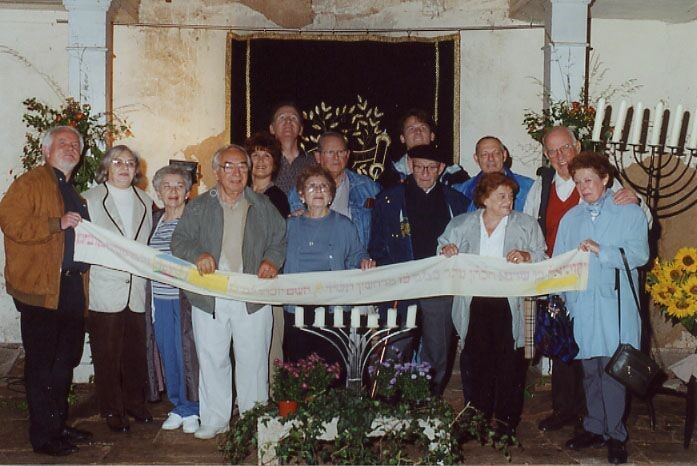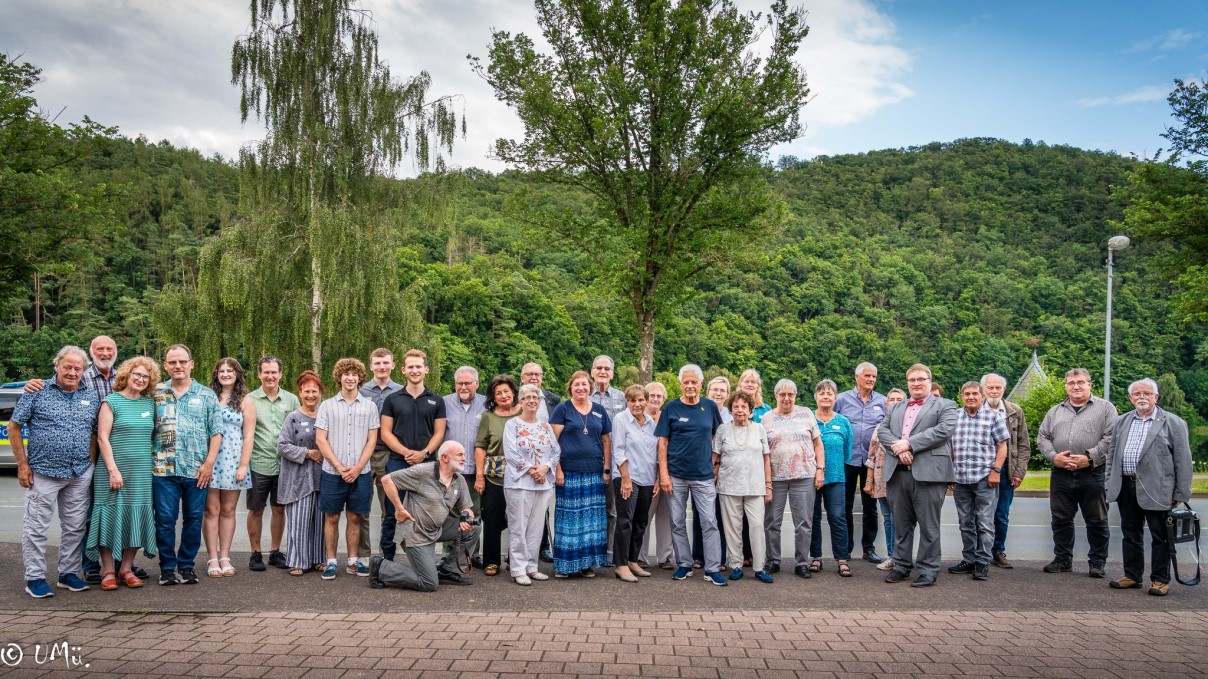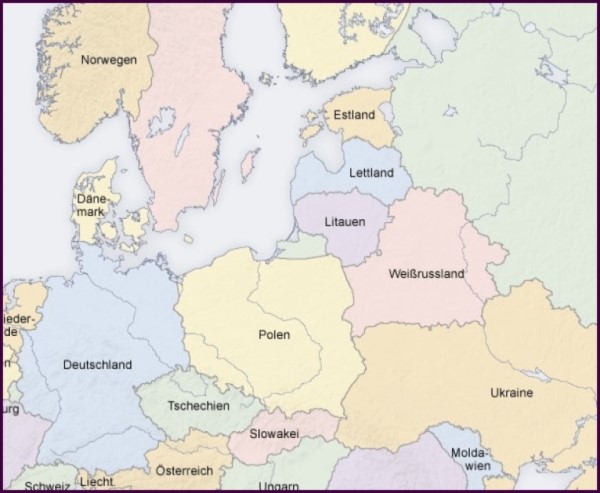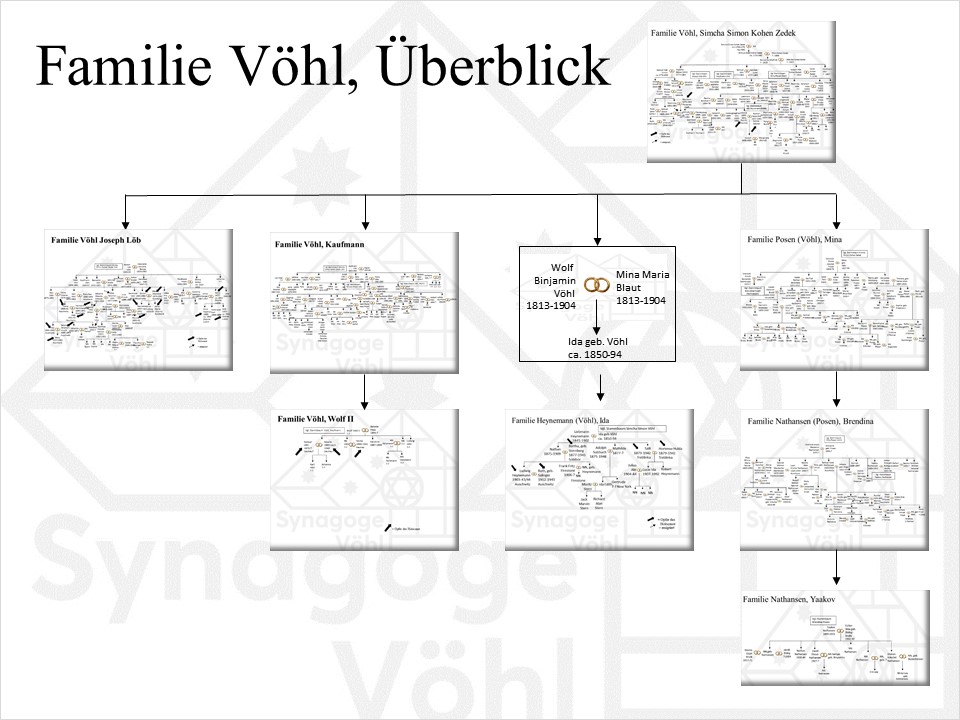Historical background and Jewish cultural goods
by Karl-Heinz Stadtler
Translated by Kimberley Simon
 Karte des Fürstentum Waldecks 1789
Karte des Fürstentum Waldecks 1789©Thomas Höckmann 2005
Itter dominion- district of Voehl
The medieval Ittergau which extended from Herzhausen located at Lake Eder to Lake Diemel developed in the 12th century into the Itter dominion, later becoming the district of Vöhl. In connection with the peace settlements of the Thirty Years’ War the 20 villages became an enclave of Hesse-Darmstadt, located between Waldeck and Hesse-Kassel. The following map shows that the dominion of Itter itself had exclaves in Waldeck which were Höringhausen, Eimelrod, Deisfeld and Hemmighausen.
The Landgraviate which later became the Grand Duchy of Hesse- Darmstadt was definitely not a state friendly towards the Jewish community as several “Judenordnungen” prove. However, they allowed Jewish families to settle possibly to improve and strengthen their economy. The Jewish community consisted of families from Vöhl but also from neighboring villages like Marienhagen, Basdorf and Oberwerba. An equally large community developed in Höringhausen and smaller ones could be found in Altenlotheim and Eimelrod. When looking at the total population of these villages one can see that about 15 to 20 percent of its population consisted of Jewish families.
The oldest written record of a Jew in Vöhl dates back to 1682. By 1705, 8 houses in Vöhl were owed by Jews and only half a century later the number of Israelis as they were often called had risen to about 140.
read more

Synagogue in Voehl
The inside of the main room on the occasion of a memorial ceremony on the “Reichspogromnacht” on November 9th 1938.
In 1827 the Jews from Vöhl, Marienhagen, Basdorf, and Oberwerba built a synagogue which at the time served as a school for Jewish children until 1881. The building was hidden between the surrounding houses since it wasn´t different in its appearance. From the outside the main room which extends over three floors right next to entrance on the right side and which was used for services was not visible.
Until 1881, the left part of the building was used by the teacher and his family as living quarters. This man was Salomon Bär who had a good pedagogical education and was considered honorable in the village.
In 1938 (August) probably under pressure from the state the 13 remaining Jews sold the synagogue to a Christian family which is why the building survived the “Reichspogromnacht” on November 9th 1938, Hitler´s rule and the Second World War. The main room was used as a building material store until 1974 after which it served as a drying room for laundry. Thanks to that it remained mostly untouched with its starry blue sky and the women´s gallery which goes almost all around the building.

The Jewish cemetery
Three years after the construction of the synagogue its members sought the permission to have a Jewish cemetery at the village´s border which got granted by the community council. Before that, they were probably buried at the cemetery in Frankenau, back then about 3 hours´ walk away.
During Hitler´s rule the cemetery was vandalized twice. In 1941 the head of government in Kassel ordered the closure of all Jewish cemeteries in the then district of Frankenberg. In some places the order was not followed as promptly as in Vöhl where the cemetery was completely leveled. Gravestones where used by citizens to build their houses and by the end of the war only 45 stones were left. Those had to be put back on the cemetery by orders of the Occupying Powers.
 Home of Ascher Rothschild
Home of Ascher Rothschild
Rich traders – poor guys
Several big houses of today’s Vöhl were built and inhabited by Jews. One of the wealthiest ones was merchant, trader, and moneylender Ascher Rothschild who in the 1830´s built a noticeable house in the center of the village. In the building was a mikvah which was probably also available for other families. After 1881 it also housed the Jewish school. He even financed the construction of the ship that was built by the protestant church and which had to be torn down around 1840 due to poor condition.
Other wealthy families were the Salbergs, the Kaisers, and the Sterns; Blumes and Katzenstein were also quite successful. Among the Jewish community, however, there was also poverty; this applied to parts of the Kugelmann and Liebmann families but especially to the Lazarus family who made their living as ragpickers.
Other names of larger families in Vöhl, Basdorf, and Marienhagen are: Bär, Frankenthal, Kratzenstein, Külsheimer, Laser, Löwenstern, Meyer, Mildenberg, Schaumburg, Schönhof, and Schönthal.
The most common occupations were being a butcher, work at the spinning mill, as well as being merchants for different goods like fruits, cattle, and leather. Most of the Jews had just like the Christian families an agriculture on the side. In the middle of the 18th century Simon Mildenberg started to train Apprentice so that they would become carpenters.
Was there an integration?
For the longest time Jews and Christians used to live side by side but not in a combined community. That was until the beginning of the 19th century where their relationship started to improve slowly by steady. Numerous Jews were members of the villages council, some of them for 20 years, David Stern for 40 years. Many of them were also (co-) founders of multiple society’s and groups that were part of Vöhl´s community. Max Mildenberg who’s family was part of the singing society was an active sportsman and took part in the first soccer team as well as being known as a great track and field athlete. After Hitler became chancellor everything changed since they dissolved those clubs and got rid of their Jewish members, sometimes in a very unpleasant way.
Victims of the genocide
In 1933, 45 Jews still lived in Vöhl and Marienhagen. Gradually they moved away into bigger cities like Kassel and Frankfurt and emigrated into different counties. In August 1938 only 13 Jews remained: 3 men, 9 women and a 6-year-old boy. Some moved to Frankfurt others got deported to Riga, Sobibor, Majdanek and Theresienstadt in December 1941, June and as well in September 1942. 45 women, children, and men who have lived in Vöhl and its neighboring villages were killed in the extermination and concentration camps. On November 9th at the annual commemoration ceremony more than 70 names are being read out to remember not only Vöhler Jews but also their spouses and children.
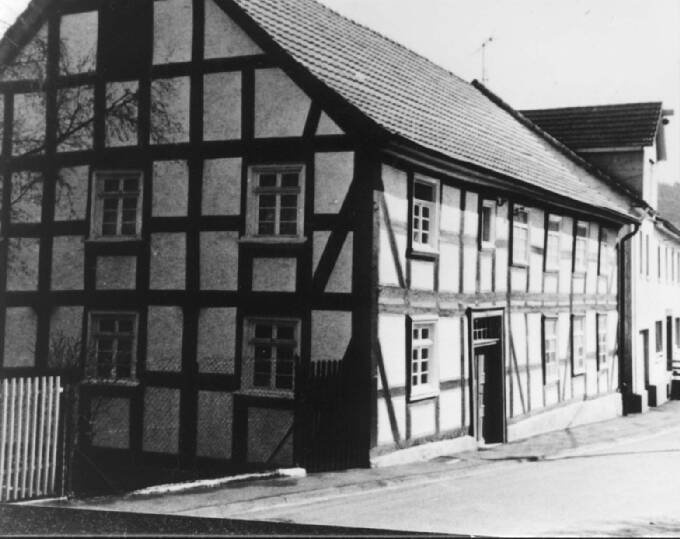
Förderkreis Synagoge in Vöhl
On November 9th, 1999, more than 70 citizens of the district of Vöhl founded the “Förderkreis Synagoge in Vöhl e.V.” and bought the old building to renovate it.
From the beginning and at every stage of construction events took place there: concerts, cabaret events, lectures, art exhibitions, and much more which the “Förderkreis” plans each and every year in a different yet unique way. In addition to cultural programs and its work at monument preservation it also researches about Jews in Vöhl and its region.

Visits by former Jewish residents
For this reason, it was important to them to invite former Jews from Vöhl, as far as they were still alive. 15 of them visited in September 2000 and told stories about their childhood in Vöhl, the horrors they went through and the suffering they and their families experienced. They gathered in front of the synagogue´s Torah wall for a group photo.
Museum in the synagogue
The main room has since been completed. In the former living quarters, pictures, documents, and cultural objects remind us of the time when Jews also shaped the image of our village and contributed to its development.

Memorial to all deportees of the Nazi era
A memorial in the garden of the synagogue, created by the Frankfurt artist E. R. Nele, is an impressive reminder of all those that got deported during the Nazi regime. It is dedicated partly to the more that 700 Jews from Waldeck-Frankenberg that either got tortured and killed at home or that got deported to extermination camps and got gassed, shot, or killed between 1933 and 1945. But it also talks about Communists and Social Democrats, Sinti and Roma, Jehovah’s witnesses, homosexuals, prisoners and of cause all the Jews from other districts and counties.
Visitor´s round of Voehl Jews, 6th of Sep 2000, Cafe Tassius, Voehl
In the year 2000, the Friends of the Synagogue in Voehl invited former Voehl residents of Jewish faith to the town. The first meeting took place in Café Tassius in Voehl on 6 September 2000 and the introductions were recorded on tape.
Henriette Hennig transcribed the audio recordings in 2018 during her work as a "Landkulturbotin".
The following Jewish persons or their descendants were present in the order in which they were seated:
Walter Mildenberg (*1921) und Marian Mildenberg, geb. Katz (*1925) USA; siehe: Stammbaum Familie Mildenberg, Levi
Gisela Frees, geb. Mildenberg (*1931) und Werner Frees Vöhl; siehe: Stammbaum Familie Mildenberg, Mayer
Ursula Behrend, geb. Mildenberg (*1924) und Howard Behrend (*1923) USA; siehe: Stammbaum Familie Mildenberg, Levi
Carol Baird, geb. Davidsohn (*1944) her grandmother was Ida D., geb. Frankenthal (*1945) und Stephen Baird ; USA; siehe: Stammbaum Familie Frankenthal, Herz
Geffroy Baird (*1974) his great-grandmother was Ida Davidsohn., geb. Frankenthal; USA; siehe: Stammbaum Familie Frankenthal, Herz
Walter Rothschild (*1920) und Sonja Rothschild, geb. Jäger Argentinien; siehe: Stammbaum Familie Rothschild, Ascher + Sprinz
Richard Rothschild (*1905) und Gerda Rothschild, geb. Westfeld (*1913) Israel and Germany; siehe: Stammbaum Familie Rothschild, Ascher + Sprinz
Rudolf Rothschild (*1931) und Sigrid Rothschild, geb. Mayer Argentinien; siehe: Stammbaum Familie Rothschild, Ascher + Sprinz
Complete transcript of the introductory round
| Person | Funktion |
|---|---|
| Kurt-Willi Julius | Förderverein Synagoge in Vöhl |
| Ilse Schenk | Förderverein Synagoge in Vöhl |
| Dr. Ingrid Engelsing | Ärztin in Vöhl |
| Barbara Sahra Küpfer | Förderverein Synagoge in Vöhl |
| Heinz Schäfer | Förderverein Synagoge in Vöhl |
| Anna Evers | Förderverein Synagoge in Vöhl |
| Günter Maier | Pfarrer in Vöhl |
| Claus Hömberg | Architekt der Renovierung |
| Birgit Stadtler | Förderverein Synagoge in Vöhl |
| Sandra Stadtler | Förderverein Synagoge in Vöhl |
| Peter Göbel | Förderverein Synagoge in Vöhl |
| Karl-Heinz Stadtler | Förderverein Synagoge in Vöhl |
This round of visitors was the start of the programme for the Visit by former Jewish residents in September 2000.
Visit in the year 2024
Fifteen descendants of Vöhl Jews visited Vöhl for the 25th anniversary of the association. Here are pictures of the visit.
11th July 2024 The group photo at the beginning of the evening. On the left, the block of nine from the Baird family, followed by Ruben and Ingrid Herzberg from Hamburg, Camille Calman and Elizabeth Foote as well as Michael and Dalia Dimor. 2nd from right: District President Mark Weinmeister from Kassel.
 Foto: Walter Schauderna
Foto: Walter Schauderna
11th July 2024 The district president Mark Weinmeister from Kassel and the chairman of the association Karl-Heinz Stadtler.
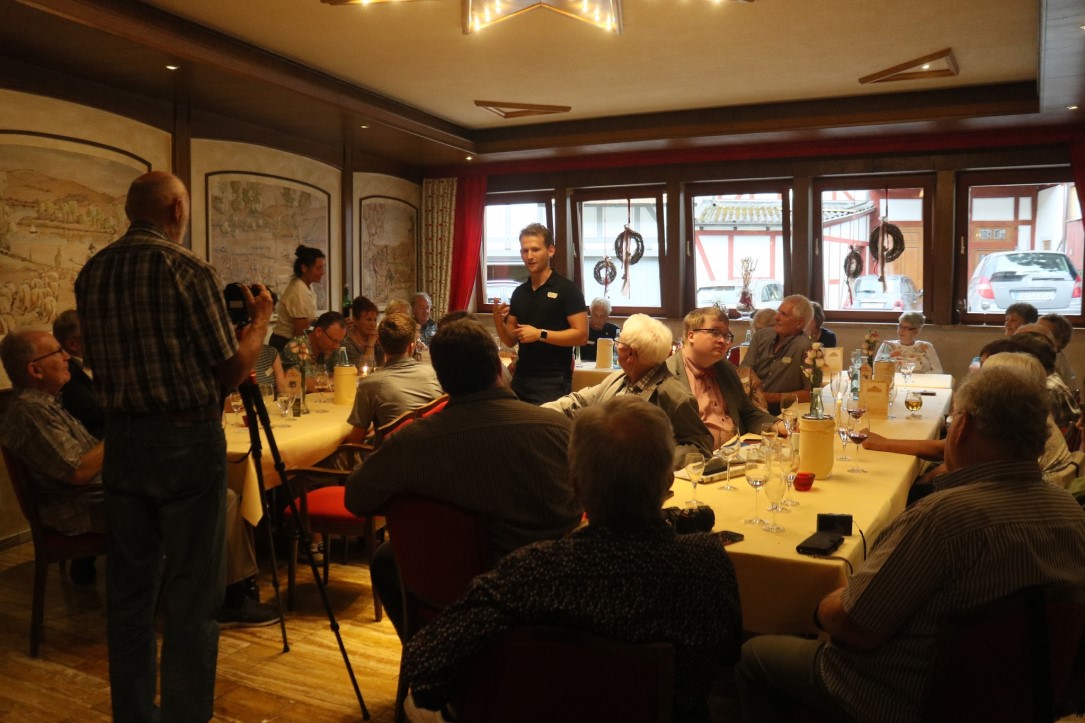 Foto: Walter Schauderna
Foto: Walter Schauderna
11th July 2024 All those present introduce themselves. This is Flynn Baird, who incidentally currently works at Porsche in Stuttgart, the city that his great-grandparents left for the USA in 1939 and therefore escaped the Holocaust.
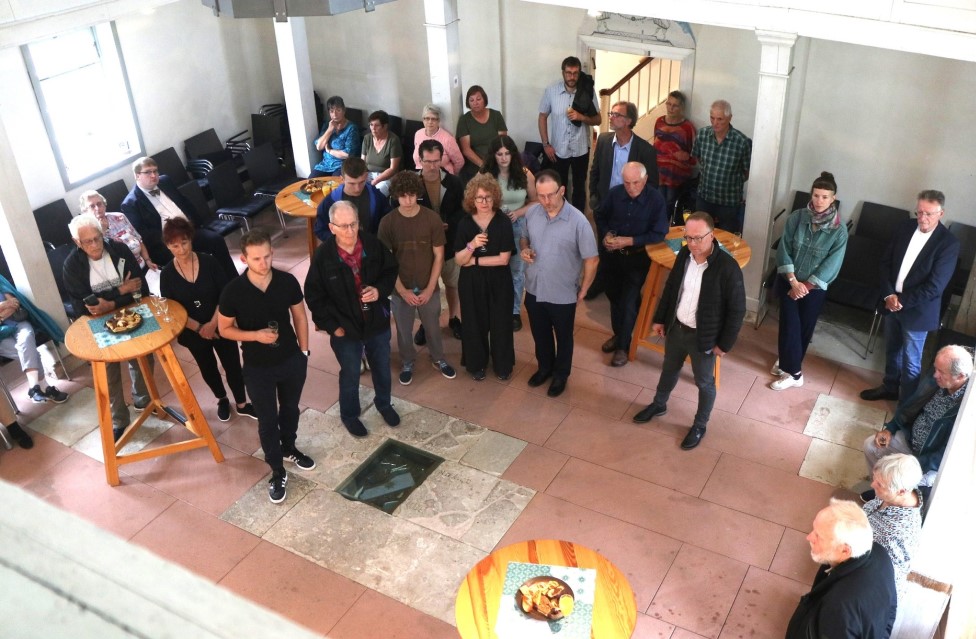 Foto: Walter Schauderna
Foto: Walter Schauderna
12th July 2024 At the "reception", H. Heider from the Network for Tolerance, which sponsored the anniversary, to the right of her, Th. Brömmelhaus from the association Rückblende - Gegen das Vergessen Volkmarsen; to the left in front of them Mayor K. Kalhöfer, in the left door frame Pastor M. Müller, at the right door frame of Mr and Mrs Göbel, at the left pillar Camille Calman and Elizabeth Foote, in the foreground Michael Dimor and the Baird family.
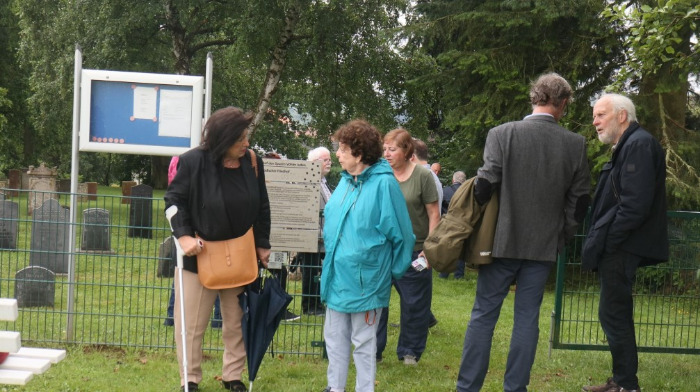 Foto: Walter Schauderna
Foto: Walter Schauderna
12th July 2024 Visiting the Jewish cemetery: Ingrid Herzberg and Dalia Dimor, behind them Eliszabeth Foote. On the right: Günter Maier and Christian Schnatz.
 Foto: Walter Schauderna
Foto: Walter Schauderna
12th July 2024 Ulrich Müller and Ruben Herzberg at the memorial plaque, Elizabeth Foote walks there. Carol Baird and Karl-Heinz Stadtler in the foreground.
 Foto: Walter Schauderna
Foto: Walter Schauderna
12th July 2024 Father Steve Baird and son Geoffrey Baird with grandchildren Galen and Flynn.
 Foto: Walter Schauderna
Foto: Walter Schauderna
12th July 2024 Artist and craftsman Christian Schnatz explains how he made the memorial plaque at the cemetery. from left to right: Michael Dimor, Theo Brömmelhaus, retired colonel Jürgen Damm, Ingrid and Ruben Herzberg
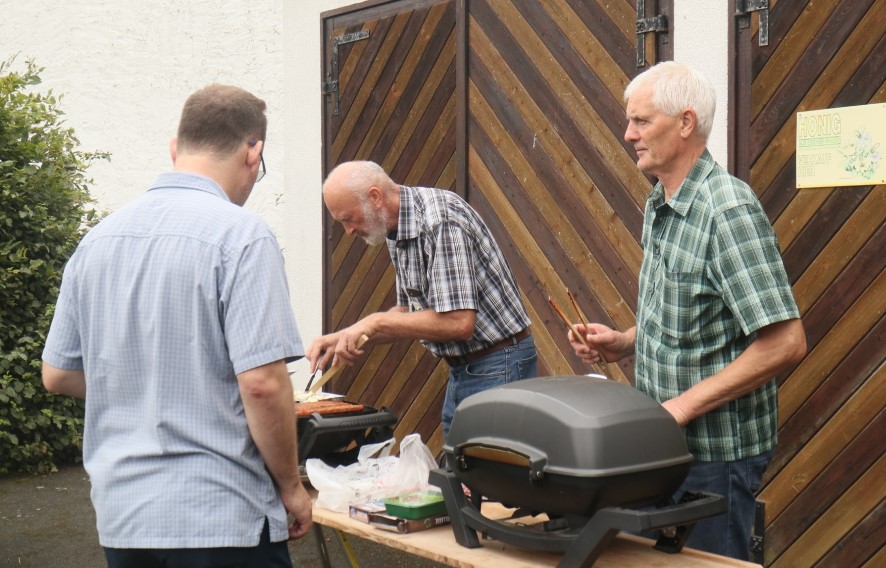 Foto: Walter Schauderna
Foto: Walter Schauderna
12th July 2024 Lunch in Müller's garden. Ulrich Müller and Peter Göbel at the two barbecues, beef and pork strictly separated.
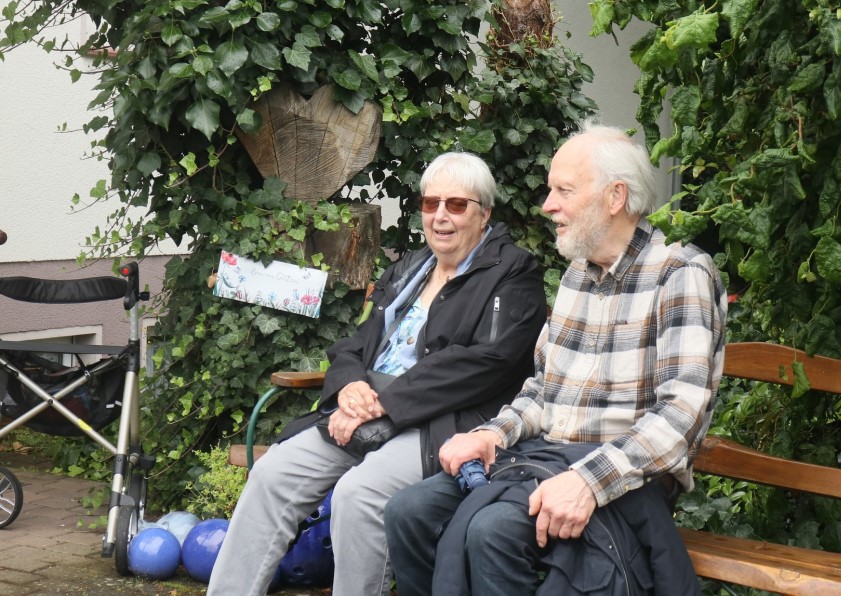 Foto: Walter Schauderna
Foto: Walter Schauderna
12th July 2024 Anna Evers and Günter Maier from the support group.
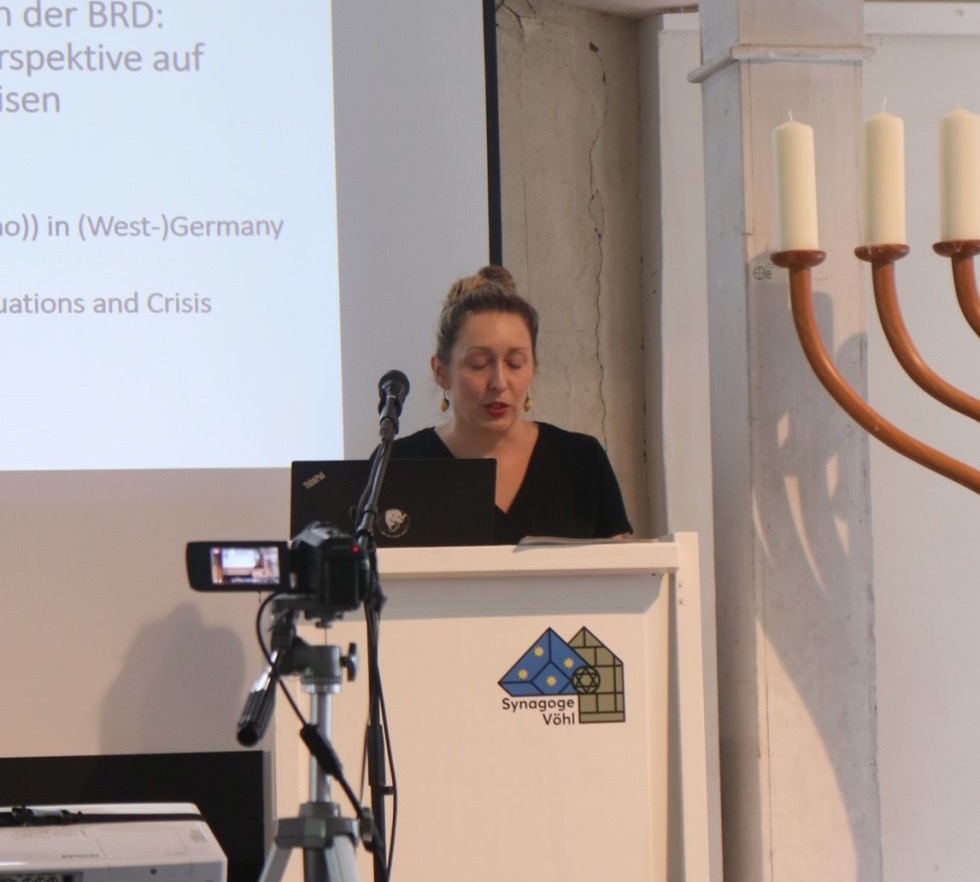 Foto: Walter Schauderna
Foto: Walter Schauderna
12th July 2024 In her lecture, Prof Dr Christiane Brüning asked herself and us whether and, above all, how the Shoah should be remembered in the future.
 Foto: Walter Schauderna
Foto: Walter Schauderna
12th July 2024 Sahra Küpfer at the Kiddush on Friday evening before the anniversary celebration in the synagogue.
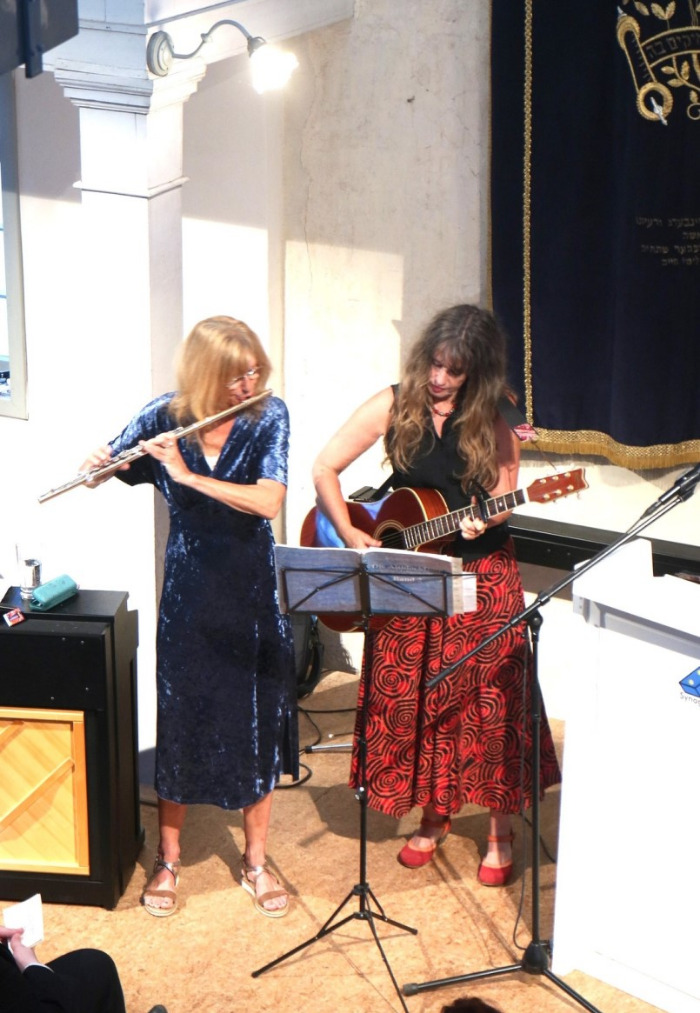
12th July 2024 Sahra Küpfer and Beate Lambert provide the musical framework for the celebration..
12th July 2024 Welcome by the chairman of the synagogue support group in Voehl.
12th July 2024 Carol Baird, assisted by Karin Keller, for the descendants of the Frankenthal family
12th July 2024 Daniel, Noah and Steve Baird with the song "Deportieren", which deals with the question of whether anyone has really realised that no one is coming back.
 Foto: Walter Schauderna
Foto: Walter Schauderna
12th July 2024 Philipp Wecker, 2nd Chairman of the Sponsors' Association, presents certificates and pins to the new honorary members, represented here by Peter Göbel.
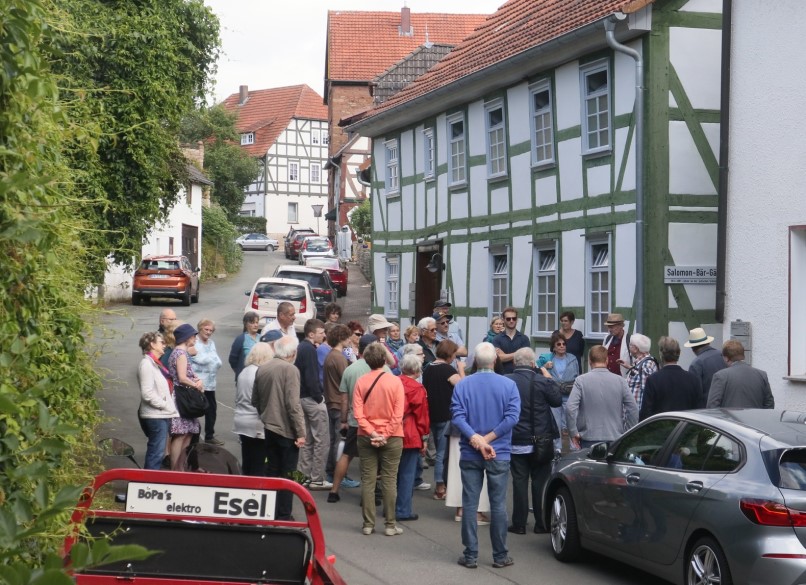 Foto: Walter Schauderna
Foto: Walter Schauderna
13th July 2024 There was great interest in the naming of the previously nameless alleyway below the synagogue as Salomon Bär Gässchen.
 Foto: Walter Schauderna
Foto: Walter Schauderna
13th July 2024 Salomon Bär was a teacher at the Jewish school in Vöhl for 40 years. He lived from 1815-81.
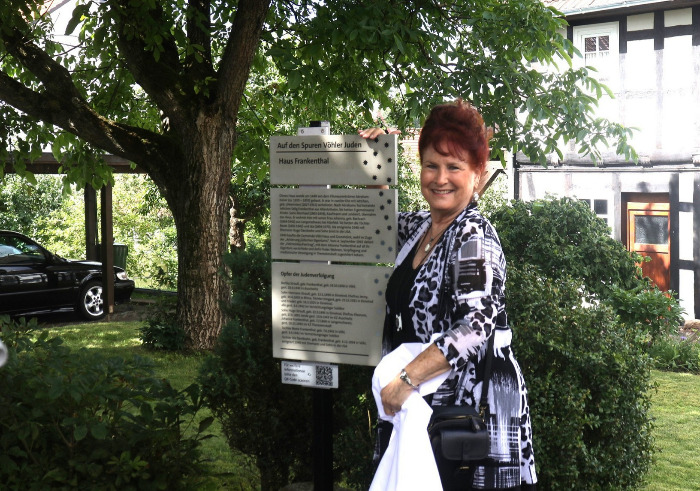 Foto: Walter Schauderna
Foto: Walter Schauderna
13th July 2024 Carol Baird enthüllt die Haustafel vor dem Haus auf dem Schulberg.
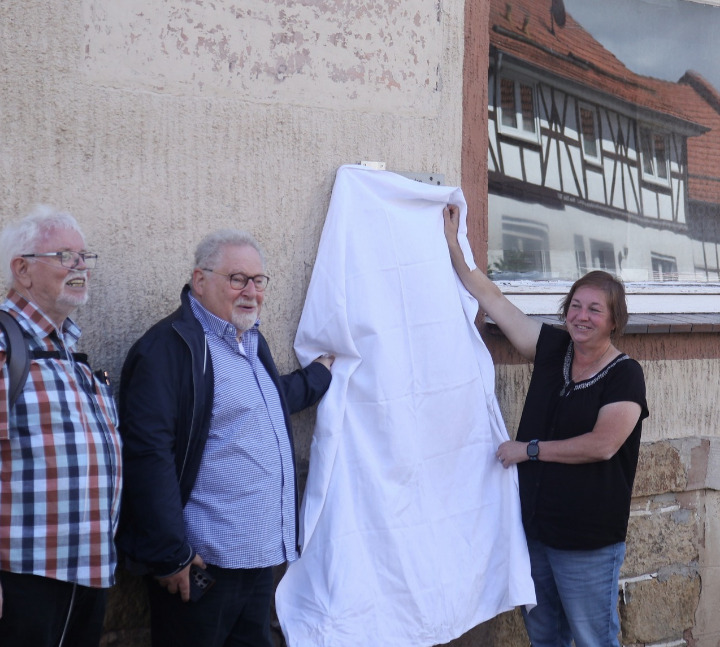 Foto: Walter Schauderna
Foto: Walter Schauderna
13th July 2024 Ruben Herzberg and Elizabeth Foote unveil the plaque on the house at Arolser Str. 8.
 Foto: Walter Schauderna
Foto: Walter Schauderna
13th July 2024 Michael Dimor in front of the plaque on the property at Arolser Str. 13.
 Foto: Walter Schauderna
Foto: Walter Schauderna
13th July 2024 Auf dem Podium vlnr.: Dr. Wolfgang Werner, "Arbeitskreis Rückblende - Gegen das Vergessen" in Volkmarsen; Dr. Annegret Wenz-Haubfleisch, Landsynagoge Roth; Dr. Marion Lilienthal, Gedenkportal Korbach; Moderator Prof. Dr. Dietfrid Krause-Vilmar; Sebastian Sakautzki, Gedenkstätte und Museum Trutzhain; Dr. Martin Arnold, Verein der Freundinnen und Freunde jüdischen Lebens im Werra-Meißner-Kreis; Julia Drinnenberg, Jüdische Abteilung im Museum Hofgeismar.
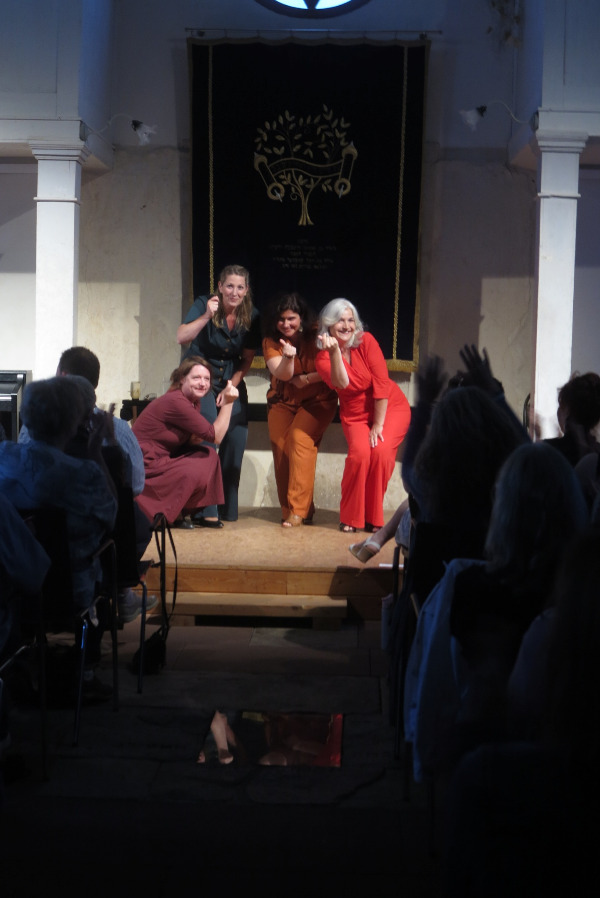 Foto: Walter Schauderna
Foto: Walter Schauderna
13th July 2024 Aquabella. Her only instrument is her voice. A capella concert with Maria Thomaschke, Pamela Neuffer, Nina Gronich and Bettina Stäber.
 Foto: Ulrich Müller
Foto: Ulrich Müller
14th July 2024 Church service in the protestant Martinskirche in Vöhl.
 Foto: Walter Schauderna
Foto: Walter Schauderna
14th July 2024 Pastors Matthias Müller and Günter Maier conducted the service together, also in dialogue.
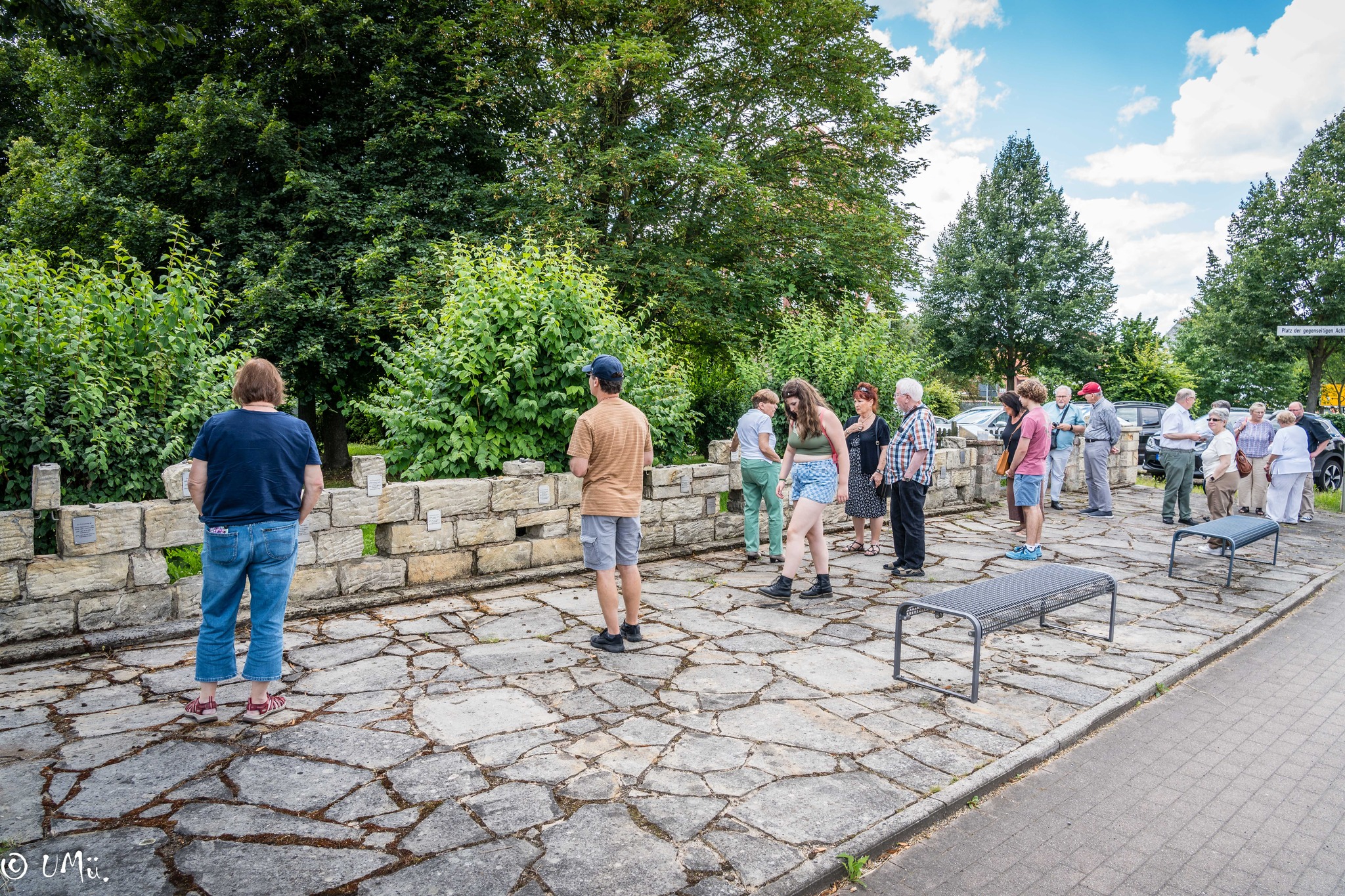 Foto: Ulrich Müller
Foto: Ulrich Müller
14th July 2024 At the invitation of Mr and Mrs Klein, visit to the Place of Mutual Respect at the entrance to the Jewish cemetery in Volkmarsen.
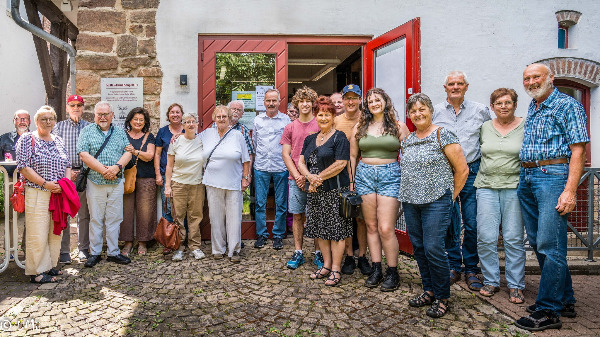 Foto: Ulrich Muller
Foto: Ulrich Muller
14th July 2024 US-Americans, Hamburgers, Volkmarser and Vöhler at the entrance to the Gustav-Hüneberg-Haus in Volkmarsen.
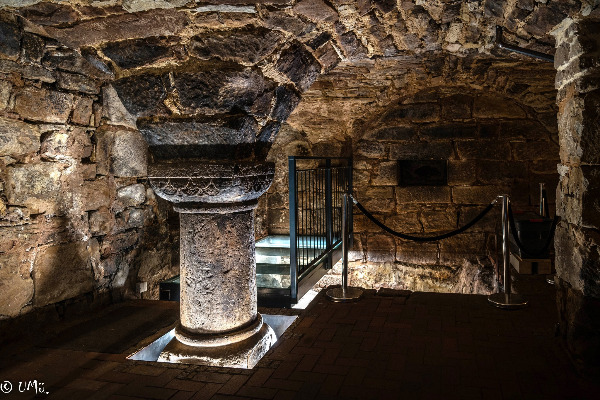 Foto: Ulrich Müller
Foto: Ulrich Müller
14th July 2024 The medieval mikvah in the Gustav Hünberg House in Volkmarsen: standing on the glass plate, you can see the water in the depths.
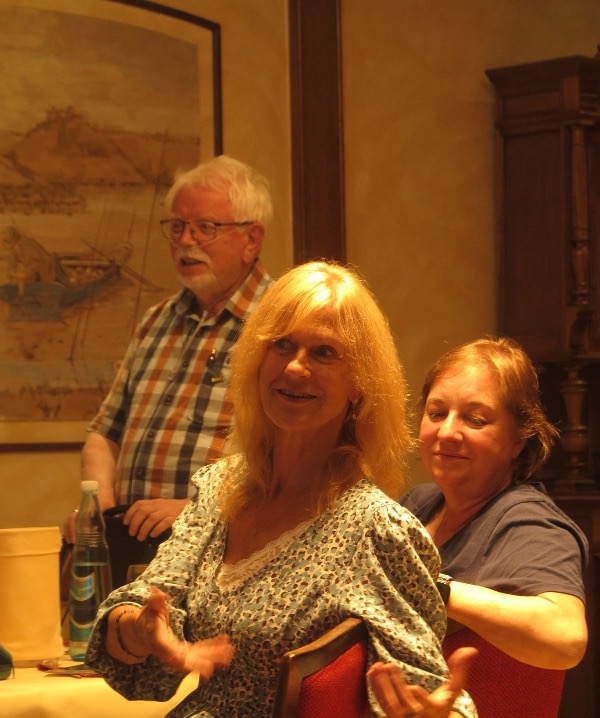 Foto: Walter Schauderna
Foto: Walter Schauderna
14th July 2024 Farewell evening with Sahra Küpfer, Elisabeth Foote and Karl-Heinz Stadtler. Karl-Heinz Stadtler thanks the guests for coming and the members of the Board of Directors and their partners for their commitment before and during the anniversary.
 Foto: Walter Schauderna
Foto: Walter Schauderna
14th July 2024 Farewell talks.
Creating and updating the directory of Voehl Jews
By Karl-Heinz Stadtler
read more
Why is this compilation put on the web?
The most important reason is that again and again inquiries come, which refer to persons and families from Vöhl. Mostly Jews inquire who are looking for ancestors and relatives from other countries. Sometimes they are also persons who are working on the Jewish or common past in their German home community - similar to what happens in the Vöhl Förderkreis Synagoge - and are therefore on a "search for traces".
However, the information contained in this directory may also be of interest to all citizens of Vöhl and of the North Hessian region who would like to know how people used to live and how Jews and Christians lived side by side and sometimes also together.
Due to the abundance of available information, the data can only be put online bit by bit. It is intended to do this in alphabetical order. Furthermore, where possible, the information will be supplemented by photos and documents.
Furthermore, family trees will be compiled where it seems reasonable. They are interactive. By clicking on the individual names, you can also access further information about the person in question from the family tree.
Preliminary remarks
This directory of Vöhl Jews is “in progress”. This means above all: it is not complete and cannot become so.
For several years the author has collected data and facts from various sources (State Archives of Marburg, Municipal Archives of Vöhl, various reference books from the region, conversations with contemporary witnesses, etc.) and compiled them according to persons.
Initially, there was the assumption that there was only little information altogether, because it was said that shortly before the arrival of the American occupation troops in April 1945, the Vöhl baker's ovens had not gone out for a few days. In fact, there are not many records in the Vöhl archives from the twelve years of the Thousand Year Reich.
But citizens of Vöhl still knew a few things to report from memory. And then there are also those Jewish fellow citizens who survived the Holocaust, with whom there is active contact, not only since we had many of them as guests in Vöhl.
Incidentally, those twelve years of National Socialist rule are a relatively short period of time compared to those 260 years from 1682 to 1942 during which Jews were verifiably living in Vöhl.
The directory is not free of errors. There are several reasons for this:
Until the 20th century Jews had not only their civil, but in addition a religiously motivated first name. The latter was not used publicly, but sometimes it was; and therefore it cannot be excluded that persons appear who are identical with others.
Also sometimes cose forms (e.g. Malchen for Amalie, Rickchen for Friederike, Jettchen for Henriette and Johannette) were used or names were modified almost arbitrarily. That a "Moses" was sometimes only called Mose, that there was the "Isaak" also as "Isai", "Isak" or Isack", may still be comprehensible; if a "Feist" appears however also as "Veit" or even "Uri", then the assignment is already more difficult. In Korbach there was a family Kugelmann, where almost every female person was called "Rickchen"; one of them, who was actually called "Helene", married to Vöhl, where there were also several families Kugelmann.
In addition, persons with the same first name and surname often lived at the same time. So it cannot be excluded that information was assigned to the wrong person. In at least one case the author suspects that there were such two persons of the same name at the same time; but the source situation is still too vague to assert the existence of the second person. So, possibly, information that actually refers to two persons is assigned to only one.
Also, officials of the municipal or district authorities were by all means not always as conscientious as they are said to be today. For example, a name was spelled one way and another another; sometimes there are several birth or marriage dates for the same person in the files; tax data were sometimes carried over to the next year without exact verification.
And, despite all the care taken, there may well be errors due to negligence or error on the part of the author of this compilation.
All these possible sources of error are the reason why this directory has been described in the introductory sentence as being "in progress". Even after it has been "put online," it will continue to be researched, changed, and added to.
In one point the information is intentionally incomplete: For the period of persecution of Jews in the Third Reich, so-called perpetrators - i.e. persons who were actively involved in acts against Jews in the region - are not named. They are no longer alive, their descendants are not responsible and should therefore not be incriminated by public mention of their names.
Legal involvements of Jews from Vöhl, on the other hand, have been presented. They provide valuable information about the position of the Jews in society, but also generally give important insights into life in Vöhl in the 19th century.
Conclusions from this information should be drawn with all caution, because the conditions at that time cannot be compared with those of today. For example, for several decades there were a great many seizures, both with and without the participation of Jews. Often there were administrative fines for violation of the Sunday rest, of course exclusively against Jews. In cases of fraud due to false weights, Jews were more often affected than Christian merchants, but this imbalance corresponded approximately to the different share of members of the two religions in the trading business. During one of these official inspections of weights, five merchants were found to have tampered with weights on the same day and were punished. Two traders were Christians, three were Jews. In the 1920s, there were also punishments for price gouging. Here, resentment as a result of growing anti-Semitism may also have played a role in legislation.
Information was provided by Christiane Kupski and Jürgen Evers. Especially with regard to the Frankenthal family, research by Carol Davidson-Baird, a descendant of Jews from Vöhl living in the USA, could be used.
Biographies of Jews from Vöhl, Marienhagen, Basdorf and Oberwerbe
assembeld by Karl-Heinz Stadtler
Vöhler Juden Buchstabe B
Vöhler Juden Buchstabe C
Vöhler Juden Buchstabe D
Vöhler Juden Buchstabe E
Vöhler Juden Buchstabe F
Vöhler Juden Buchstabe G
Vöhler Juden Buchstabe H
Vöhler Juden Buchstabe I
Vöhler Juden Buchstabe J
Vöhler Juden Buchstabe K
Vöhler Juden Buchstabe L
Vöhler Juden Buchstabe M
Vöhler Juden Buchstabe N
Vöhler Juden Buchstaben O-Q
Vöhler Juden Buchstabe R
Vöhler Juden Buchstabe S
Vöhler Juden Buchstabe SCH
Vöhler Juden Buchstabe ST
Vöhler Juden Buchstaben T - Z
Family Trees of Jews from Voehl, Marienhagen, Basdorf and Oberwerbe
assembeld by Karl-Heinz Stadtler
Family trees were created if enough data from families were available.
- Family Tree Bär
- Family Tree Blum + Mehrgeld + Reichmann
- Family Tree Blum, Joseph
- Family Tree Eberwein
- Family Tree Eberwein (E. Foote)
- Family Tree Flörsheim, Julius
- Family Tree Frankenthal, Herz
- Family Tree Kaiser
- Family Tree Katzenstein, Bär und Simon
- Family Tree Keiser; Marienhagen
- Family Tree Kratzenstein, Jacob; Marienhagen
- Family Tree Kratzenstein, Selig
- Family Tree Kugelmann, Isaak
- Family Tree Külsheimer; Basdorf
- Family Tree Laser
- Family Tree Lazarus, Hirsch Hirsch
- Family Tree Liebmann
- Family Tree Löwenstern, Israel + Bär; Basdorf
- Family Tree Meyer
- Family Tree Mehrgeld > see Family Tree Schoenthal, Marienhagen
- Family Tree Mildenberg, Levi
- Family Tree Mildenberg, Mayer
- Family Tree Mildenberg, Simon/Samuel 1848
- Family Tree Mildenberg, overview
- Family Tree Rothschild, Adolph
- Family Tree Rothschild, Adolph (E. Foote)
- Family Tree Rothschild, Ascher + Blümchen
- Family Tree Rothschild, Ascher + Sprinz
- Family Tree Rothschild, Ascher + Sprinz (E. Foote)
- Family Tree Rothschild, Selig
- Family Tree Rothschild, Selig (E. Foote)
- Family Tree Rothschild, overview
- Family Tree Salberg, Isaac und Faist
- Family Tree Schaumburg
- Family Tree Schiff
- Family Tree Schönhof
- Family Tree Schönthal; Marienhagen
- Family Tree Schönthal; Vöhl
- Family Tree Stern, David
- Family Tree Stern, David (E. Foote)
- Family Tree Stern, Kain
- Family Tree Stern, Kain (E. Foote)
- Family Tree Strauss, Jonas
- Family Tree Sternberg> see Family Tree Mildenberg, Mayer
- Family Tree Winter > see Family Tree Kratzenstein, Jacob Marienhagen
- Family Tree Vöhl, Simcha Simon
- Family Tree Vöhl, overview
Murdered 1933-1945
by Karl-Heinz Stadtler
When former Vöhl Jews or their descendants visited Vöhl in September 2000, we promised them that we in the Vöhl synagogue would always remember those people who were murdered in German names. With this directory, too, we are fulfilling our promise.This directory of Vöhl Holocaust victims also includes people who only lived in Vöhl for a very short time, e.g. as employees of merchants. The spouses or children of Vöhl Jews who left Vöhl after their marriage were also accepted.
read more
Erna Baruch, née Katzenstein
was born on March 3, 1882 as the daughter of Cäcilie and Samuel Katzenstein in a house in the lower Mittelgasse in Vöhl. In 1901 she married Albert Baruch and moved with him to Essen, where they were born with their two sons Bernhard and Heinz. She died at the age of 60 on 23 August 1942 in Auschwitz, where her son Bernhard Baruch also died a month later, on 23 September.
Max Cossen
born on 18 November 1899 in Weener, was employed as a merchant by Ferdinand Kaiser in Vöhl from 1925 to 1927. After their marriage to Paula Meyer from Eimelrod, they lived there, later in Cologne. During the 1930s they emigrated to the Netherlands and lived in Amsterdam. After the occupation of the Netherlands by Germany, they were interned in the Westerbork camp. On 7 September 1943, Max Cossen was deported from Westerbork to Auschwitz with his wife and two children. After arriving on 9 September, Paula Cossen and her daughters Marianne and Lieselotte were killed in the gas chambers. Max Cossen was forced to work for a few more months before he was killed on 31 March 1944.
Lina Goldblum, née Blum
was born on 18.7.1884 as a child of the Vöhler family Abraham and Frida Blum. In 1906 she married the merchant Adolf Goldblum from Witten and moved to him. The two ran a grocery store there. They were born with their son Heinz. In 1921, Lina Goldblum contributed to the foundation of the Memorial to the Fallen of world war. Lina Goldblum died in Wattenscheid in 1937 at the age of 53.
Julius Flörsheim
born on October 25, 1883 in Wolfhagen, was a teacher at the Jewish school in Vöhl from 1907 to 1914. In 1913 he was one of the founders of a shooting club in Vöhl. In 1914 he became a middle school teacher in Frankfurt. Immediately after the beginning of the war he was moved in and he was taken prisoner of war in the Vosges, from which he was released only four years later. Until 1935 he taught at the Brüder-Grimm-Schule in Frankfurt, then until October 1941 in educational institutions for Jewish children. In connection with the pogrom night, he was sent to the Buchenwald concentration camp for six weeks at the end of 1938. In October 1941, he was deported to Lodz along with 1,000 other Frankfurt Jews, including his wife and one of his two sons. There he died of exhaustion in early 1942, according to witnesses.
His wife Jenny Flörsheim was gassed a little later in the nearby extermination camp Chelmno.
Son Kurt Flörsheim was only taken to Auschwitz when the ghetto was evacuated from Lodz in mid-1944, worked in the so-called Sonderkommando and was then probably killed.
Beate Frankenthal
Johanna and Bernhard Frankenthal's daughter Beate was born on 7 June 1892. She was considered a very reserved woman in the village and remained single. Beate Frankenthal was deported to Kassel at the end of May 1942 and from there on Tuesday, June 1, to the east. Probably on June 3, the train arrived in Lublin. The working men had to get off there and were driven to Majdanek, while the train continued with the women, children and old men, probably also with Beate Frankenthal, to Sobibor. They were probably gassed there within 2 hours of their arrival. She had turned fifty. However, her name is listed in the memorial book of the Majdanek camp. She may have died there.
Bertha Frankenthal
was born on September 6, 1887 in Vöhl, the daughter of the Vöhler merchant Hermann Hirsch Frankenthal and his wife Emma. In several eyewitness accounts, she is described as a caring and helpful woman. After her father's early death, she continued to run his business on a small scale. She lived in a small house on Arolser Straße. Shortly after the death of her mother in the spring of 1940, she moved to Frankfurt. Berta Frankenthal was deported from Frankfurt to Kaunas in November 1941 and shot there together with nearly 3,000 Jews from Berlin, Munich and Frankfurt. She was 54.
Johanna Frankenthal, née Bachrach
Johanna Frankenthal was born on 7 July 1868 in Langenschwarz near Hünfeld as the daughter of Jakob and Marianne Bachrach and married Bernhard Frankenthal in 1891. The couple lived with their daughters Beata and Ida on the Schulberg. In the early morning of September 6, 1942, she was picked up from her house by the mayor and another leading Member of the Nazi Party and taken to Itter station. From there she was deported via Kassel on 7 September to Theresienstadt, where she died on 18 November 1942. She was 74.
Emma Hirsch, née Katz
was born on 2.1.1882 in Korbach. She married Maximilian Hirsch and moved to Sachsenhausen. The children Bernhard, Hildegard and Else were born to them. In 1934 her husband died and she moved back to Korbach. At the end of September 1939 she lived with her sister Hermine Rothschild in Vöhl for a few weeks, probably to help her after the death of her husband Alfred Rothschild, and then moved back to Korbach. On June 1, 1942, she was deported from Kassel via Lublin to Sobibor, where she probably died on June 3 in a gas chamber.
Johanna Jacobs, née Blum
comes from the old Vöhler Blum family, who have been living at least since 1705. She was born in 1890 as the daughter of the merchants Abraham and Frida Blum. Her last known place of residence is the Latvian capital Riga, where she was probably killed in the early 1940s.
Johanna Jacobs, née Laser
was born on 22 March 1890 in Vöhl as the daughter of the Jewish teacher Joseph Laser and his wife Bertha. After the death of her father in 1907, she moved to Kassel with her mother. In 1931, she married the plumber Justus Jacobs and moved with him to Gelsenkirchen. She was "evacuated" from there to Riga in January 1942. She died in Auschwitz on 5 November 1943.
Friederike Katzenstein, née Jakob
called Rickchen, was born on 24 June 1870 as the daughter of Michel and Jettchen Jakob in Sachsenhausen. In 1906, she initially came to Vöhl as a housemaid to the recently widowed Samuel Katzenstein and married the now 76-year-old man a few months later. After his death, she continued to run the business, a colonial goods shop, on her own. On 6 September 1942, she was taken out of the house by two men at four o'clock in the morning and left Vöhl with the things she could pack in a rucksack. A contemporary witness told how she saw little Rickchen Katzenstein walking along Basdorfer Straße with the rucksack on her back between two large men. She was deported from Itter station to Kassel and from there to Theresienstadt on 7 September. She died there on 19 September 1942 at the age of 72.
Gustav Lorsch
was born on August 24th, 1894 in Alsfeld. From 1911 to 1912 he worked as a clerk in Vöhl in Abraham Blum's shop. Later he lived in Giessen. During the war he disappeared somewhere in Poland. His wife Selma, née Stiefel (born 1898) and his sons Arno (born 1927) and Norbert (born 1928) were also deported to Poland in 1942; the latter two are known to have been murdered in Treblinka.
Ferdinand Kaiser
was born on January 10, 1866. His parents Levi and Selka Kaiser moved from Basdorf to Vöhl in the middle of the 19th century. Ferdinand Kaiser, father of four children, owned the "Kaiser Café" in Korbach from 1908 to 1912 together with a partner. However, he lived in Vöhl, where he also ran a shop for manufactured goods, regional products and artificial fertilizers. At the beginning of the century he was a member of the municipal council and the road commission and exercised the function of an honorary lay judge at the court. Ferdinand Kaiser was one of the founders of the war memorial for those who fell in World War I. In 1935 he sold his business in Vöhl and in 1936 moved to live with relatives in Frankfurt. On August 19, 1942, he and his wife Ida were deported from Frankfurt to Theresienstadt, where he died on December 20, 1943 at the age of almost 78.
Ida Kaiser, née Löwenstern
was born in 1869 as the daughter of Bernhard and Bertha Löwenstern in Korbach. At the beginning of February she married Ferdinand Kaiser, who had been widowed two years earlier, moved to live with him in Vöhl and gave birth to the children Anna Bertha and Erich. She also raised the stepchildren Brunhilde and Leopold. Ida Kaiser left Vöhl with her husband in 1936; they moved to live with relatives in Frankfurt. On August 19, 1942, she and her husband were deported from Frankfurt to Theresienstadt. There she died on March 17, 1943 at the age of 74.
Dina Kratzenstein, née Strauss
was born on April 14, 1867 as the daughter of a Strauss family in Eimelrod. After the wedding with the Marienhagen innkeeper, businessman and farmer Felix (Selig) Kratzenstein, she lived with him in the building that is now known as the “old country school home”. They had four children: Hermann, Hedwig, Herda and Julius. In January 1936 she emigrated to Holland with the family of her daughter Hedwig. On April 27, 1943 she was deported from the Dutch transit camp Westerbork to Auschwitz, where she was probably gassed as soon as she arrived. She was 76 years old.
Hermann Kratzenstein
was born on February 5, 1891 in Marienhagen. Right at the beginning of World War I, he was awarded the Iron Cross for bravery in the face of the enemy. In 1918 he married Emilie, née Wertheim, and moved to live with her in Niedermarsberg. The couple had three children: Erich, Ilse and Hilde. Even before the war began, they moved to the Netherlands and lived in Enschede. On April 21, 1943, Hermann and Emilie Kratzenstein were deported to Theresienstadt. The children Ilse and Erich followed on January 20, 1944. On September 28, 1944, the family was torn apart again: Hermann Kratzenstein and son Erich had to go to Auschwitz. A week later, on October 4th, Emilie Kratzenstein and daughter Ilse followed to the extermination camp. Emilie Kratzenstein (50 years old) and probably daughter Ilse (23) were killed in the gas chambers immediately upon arrival.On October 22, 1944, Hermann Kratzenstein was transferred to the Leitmeritz command of the Flossenbürg concentration camp, where he died on January 27, 1945 at the age of 53. Two months after the father, the 17-year-old son Erich Kratzenstein died on March 21, 1945 in the Flossenbürg concentration camp.The daughter Hilde, who was married in the Netherlands, had also been deported to Auschwitz and was taken to the block for medical experiments in the main camp. She survived after an odyssey through several other camps.
Antonie Kugelmann
called Toni, was born on February 5, 1886 as the daughter of Isaak and Sara Kugelmann. She grew up with her four siblings in a house on Kirchweg. In Frankfurt she learned the trade of a tailor and worked as a housekeeper. In 1921 she was one of the founders of the Memorial for the Fallen in World War I at Maßloh, which she felt obliged to do mainly because her brother Max had died in this war. In the mid-thirties she lived in Cologne. There has been no evidence of her since her deportation to Lodz. She may have been around 55 years old.
Ruth Katzenstein, née Mildenberg, then Kugelmann
was born on December 8, 1911 as a child of Moritz and Helene Mildenberg in Vöhl. After the parents' divorce, the mother had taken her maiden name again and probably passed it on to her two daughters. Ruth married Helmut Katzenstein and lived with him and their son Robert in Amsterdam during the war. On August 31, 1943, she was deported from Westerbork to Auschwitz with her husband and son and more than 1,000 Jews. She died on September 3, 1943 in Auschwitz at the age of 32. Son Robert Katzenstein, just 3 years old, died with her. Husband Helmut Katzenstein was referred to the other side during the selection process, worked for six months and died at the age of 33 on March 31, 1944.
Helene Kugelmann
was born on October 8, 1888 in Korbach. In 1911 she married the butcher Moritz Katzenstein from Vöhl and moved in with him. They had two daughters, Ruth and Else. In 1924 they got divorced. Helene Mildenberg moved with her daughters to Korbach and took her maiden name again. In the 1930s she emigrated to the Netherlands with her daughter Ruth Katzenstein and her family and lived with them in Amsterdam. In 1938 she visited her daughter Else in Palestine, perhaps to see her grandson Dimor. Unfortunately, she didn't stay there, but traveled back to the Netherlands. On September 21, 1943, she and 978 other Jews were deported from Westerbork to Auschwitz. Immediately after the train arrived, she died in the gas chambers on September 23, 1943. It was just before her 55th birthday.
Helene Külsheimer
was on 15.2. Born in Basdorf in 1874 as the daughter of the dealer Bendix and his wife Rosa Külsheimer, where she lived with her five siblings. There is evidence that the Külsheimer family lived there before 1800. Helene Külsheimer then lived in Bad Wildungen and from the mid-30s in Kassel. On September 7, 1942, she was deported to Theresienstadt, where she slept in an attic for five months and was given bread and potatoes to eat from time to time. She died there in January 1943 of dysentery and typhus. A rabbi gave the funeral speech for 50 dead at the same time. She was buried in a beautiful linen cloth, as a friend wrote to the relatives in Palestine
Leopold Laser
was born on February 29, 1884 as the son of the Jewish teacher Joseph Laser and his first wife Karoline in Vöhl, where he grew up with his six siblings. The Lasers lived in the large house on Arolser Strasse that Ascher Rothschild had built and which also housed the Jewish school. Leopold Laser was an apprentice at Eisenach, then also worked in Bochum and Hüsten and married Else Goldberg. He last lived with her in Hagen. On March 2, he was deported to Auschwitz together with his wife Else-Eva, née Goldberg, and their son Heinz-Egon. Since they are not mentioned in the files there, it can be assumed that all three of them were gassed and cremated as soon as they arrived. Leopold and Else-Eva Laser were 59, Heinz-Egon was 18 years old.
Markus Lazarus
was born on June 18, 1867 in Oberwerba as the son of Hirsch and Schönchen Lazarus. Around 1890 he married Minna Rosenbaum, moved with her to Vöhl and lived in a house in the neighborhood of what would later become the Fleck house. Two children were born to them, the second of whom died after a few days. Around 1900 he married Minna Müller from Herleshausen. In 1901 their son Sally was born. From 1905 they lived in Kassel. On September 7, 1942, Markus and Minna Lazarus were deported from there to Theresienstadt. Markus Lazarus died there on May 4, 1943, his wife Minna Lazarus, née Müller, six weeks later on June 19, 1943. Son Sally Lazarus died on February 25, 1945 in the Mauthausen concentration camp.
Minna Lazarus
was on 8.2. Born in Oberwerba in 1879 as the daughter of Hirsch and Schönchen Lazarus and moved with them to Vöhl, where she grew up. From 1915 she lived in Kassel; from there she was deported to the Riga ghetto on December 9, 1941. There her trail was lost.
Ludwig Meyer
born on October 17, 1912 in Bremke, son of the Jewish teacher Louis Meyer and his wife Paula, lived with his family between 1914 and 1926 in Vöhl, then in Korbach. According to the brother, he was a victim of the Holocaust. Nothing is known about the time and place of death.
Minna Meyer, née Kaiser
was born on October 29, 1864 in Vöhl as the daughter of Levi and Selka Kaiser. She was the sister of the Vöhl merchant Ferdinand Kaiser. In 1889 she married Meier Meyer and lived with him in Bremen. On November 8, 1941, she and 1,000 other Jews were deported from Hamburg to Minsk, where she probably did not live long due to her advanced age.
Jenny Mildenberg
was born on May 6, 1887 in Wohnbach, Friedberg district, and was the first wife of Max Mildenberg (the elder). With him she had the son Leo. She separated from her husband and lived with her son mostly in Bad Mergentheim. In July 1942 she was deported to Auschwitz.
Max Mildenberg
was born on January 6, 1902 to Salomon and Amalie Mildenberg. He spent his youth with his sister Rosalie in the house at 7 Mittelgasse, next to the synagogue. Among other things, he was a member of the sports and choral clubs as a teenager. In December 1930 he married the evangelical midwife Marie Luise Thomas. The following year their daughter Gisela was born.Max Mildenberg ran a general store initially for a short time in Henkelstrasse, then in what is now Mittelgasse, first in house number 15, then in number 5; Most recently he worked for the Rohde company in road construction and lived in his parents' house (Mittelgasse 7).On November 10, 1938, he was arrested by three police and NSDAP representatives from Vöhl and deported to Buchenwald via Kassel. As inmate No. 25388 he lived there in Block 4a until March 1939. One of the employees of the concentration camp, as he later told us at home, was a young Vöhler. He was released on February 7, 1939, on condition that he had to leave Germany within a year and after his family had presented an immigration permit for the Dominican Republic and paid a large sum to the Kassel SS. Max Mildenberg left Vöhl and went to Brussels via Remscheid and Cologne. He wanted to catch up with his wife and child, but this was no longer possible because of the start of the war. After the beginning of the "western campaign" in the spring of 1940, he was first interned in the Le Vigean camp in central France, then transferred to Saint Cyprien (on the Mediterranean Sea, near the Spanish border) 74th labor column deployed in the arsenal of Roanne on the Loire. In August he was interned in this column in Fort Chapoly on the western outskirts of Lyon. From there he was taken to the Drancy transit camp northeast of Paris.On September 2, 1942, he was deported by train from Drancy near Paris to Auschwitz, where he was probably killed in the gas chambers of the so-called White Bunker on September 4, as soon as the train arrived.
Minna Mildenberg, née Spier
was born in Allendorf an der Lumda in 1893. She was the first wife of the butcher Albert Mildenberg from Vöhl, had a daughter Margot with him and they lived in Frankfurt. When he emigrated, she did not want to accompany him. As a domestic worker, she lived in Mainz with her daughter Margot Mildenberg, who was also a domestic worker. They were initially concentrated in a regional assembly camp in Mainz, then in the central assembly camp of the People's State of Hesse in Darmstadt, and on March 25, 1942, along with 1,000 other people, were deported to the Piaski ghetto in the Lublin region. Unless they perished there in the following weeks from illness, hunger etc. or were shot during "actions" in the local cemetery, you could have been the victim of the deportation of a large part of the ghetto inhabitants to the Sobibor extermination camp at the end of June 1942, where the most of them were gassed shortly after their arrival. There is not a single survivor of this deportation.
Sophie Nussbaum, née Frankenthal
was born on June 17, 1889 in Vöhl. In 1912 she married the merchant Emanuel Mendel Nussbaum and had with him the son Joseph and the daughter Siddi. In 1921 she made a contribution to the erection of the war memorial for those who fell in World War I on the Maßloh. The Nussbaums lived in the Hünfeld district and later moved to Frankfurt. Together with her husband, she was deported to Theresienstadt on September 16, 1942, and from there to Auschwitz on January 23, 1943, where she was probably killed. Her husband Emanuel Nussbaum died on December 23, 1942 in Theresienstadt. She was 53 and he was 61 years old.
Harry Karl Plaut
Husband of Klara Külsheimer from Basdorf, lived with his wife in Duisburg before he was deported to Izbica in April 1942. Most likely he died that same year either in Izbiza or in one of the nearby extermination camps Belzec, Majdanek or Sobibor.
Alfred Rothschild
was born on October 4, 1871 in Vöhl as the son of Moritz and Karoline Rothschild, whose Vöhl family tree goes back at least to 1705. In 1904 he married Hermine Katz in Korbach. A year later son Richard was born, who emigrated to Israel in 1935 after a short apprenticeship in the Hachschara (preparatory camp) Grüsen. Alfred Rothschild received the Iron Cross in the First World War, which he often attached to his chest in the 1930s when he was out and about in the village.Alfred Rothschild owned the “Prinz Wilhelm” inn with an attached grocery store. In the 1920s and early 30s he was the director of the amateur theater group and an elected member of the Vöhl municipal council. In the local elections in March 1933, he ran for the local council, but was no longer elected.On the night of November 10th to 11th, 1938, he was arrested and deported to the Buchenwald concentration camp via Kassel. One week after his return in early September 1939, he died on September 13 at the age of 67 as a result of the effects of the concentration camp treatment in his brother-in-law's house in Korbach.
Hermine Rothschild, née Katz
was born on August 4th, 1877 as the daughter of the Korbach grain trader Salomon Katz and his wife Johanna and lived with her husband Alfred in Vöhl after their wedding. Together they ran the “Prinz Wilhelm” hotel. She is said to have been a very good cook. After the hotel was aryanized and Alfred's death, she rented a house on Henkelstrasse.She disappeared from Vöhl on May 29, 1942. On June 1st she was deported from Kassel via Lublin to Sobibor, where she probably died in a gas chamber on June 3rd. Sister Emma and brother Siegfried belonged to the same transport.
Selma Rothschild
was born on February 10, 1867 as the daughter of Moritz and Karoline Rothschild and was the older sister of Alfred Rothschild. Until she was deported, she lived on the top floor of the house built by her grandfather Ascher on Arolser Strasse. At the beginning of September 1942 she was taken from her apartment, on September 6th from Itter train station to Kassel and then to Theresienstadt. On September 29, she was taken to the Treblinka extermination camp together with 2,000 Jews and gassed there on October 1 or 2, 1942.
Mathilde Scharff, née Nussbaum ,
born on April 22nd in Niederaula, worked from June 1910 as a so-called support in the household with businessman Ferdinand Kaiser.During the war she was deported to an unknown destination. Where and when she died is unknown.
Bertha Schiff, née Hirsch
Born on August 5, 1875 in the province of Posen, came to Vöhl with her husband at the end of the 19th century and lived here in a house that was demolished many years ago at the intersection of Arolser Str./Schulberg. In 1912 she moved to Korbach with her husband. On July 15, 1942, she was brought to Kassel. On September 7, 1942 she came to Theresienstadt, where she died on May 6, 1944 at the age of 69.
Ernst Schönhof
was born on June 23, 1864 in Vöhl as the son of Jacob and Rosalie Schönhof. He lived in Hamburg with his wife Bertha, née Oestreicher. On August 18, 1942, his wife was deported from Frankfurt to Theresienstadt. Berta Schönhof died there on September 21, 1942. On September 27, Ernst Schönhof was also brought from Darmstadt to Theresienstadt. He died there on November 2nd as a result of the catastrophic living conditions.
Louis Schonthal
was born on April 1, 1895 in Marienhagen as the son of Moses and Regine Schönthal. In 1925 he married Rosa Löwenstein from Affoldern. In 1927 their daughter Ilse was born to them. They lived in Marienhagen, first in house number 50, which burned down in 1928 as a result of a lightning strike, then in house number 35 on Hauptstrasse. Louis Schönthal was a trader by profession. In 1937 he moved to Herford with his family. In December 1941 they were deported to Riga. Louis Schönthal is said to have been killed by a shot in the neck while punishing.
Rosa Schönthal, née Löwenstein
called Alma, was born on December 13th, 1902 in Affoldern. After her marriage she moved to her husband Louis in Marienhagen, in 1937 to Herford. Together with their 14-year-old daughter, the Schönthals were deported to the east in December 1941. Around the turn of the year 1941/42, according to other information in 1944, she is said to have been shot together with her daughter.
Ilse Schonthal
was born on November 15, 1927 as the daughter of Louis and Rosa Schönthal in Marienhagen. In 1937 she moved with them to Herford, and in December 1941 the 14-year-old was deported to the east with her parents. A book about the Herford Jews reports that Ilse Schönthal died when she threw herself into her mother's arms to protect her and was shot with her.
Albert Stern
was born on June 22nd, 1869 as the son of David and Bertha Stern and lived in Vöhl. He and his sister owned houses 1 and 3 in Mittelgasse, where they ran a shop. In the mid-thirties, the siblings sold the Vöhler houses and moved to Frankfurt. On September 15, 1942, Albert Stern and his sister Rosalie were taken to Theresienstadt. Albert died at the age of 73 in October 1942 in Theresienstadt.
Rosalie Stern
Born on September 22, 1866, was Albert Stern's older sister. Both remained unmarried and lived very withdrawn. Her ancestors had lived in Vöhl since at least 1705. In the mid-30s they sold their houses and moved to Frankfurt. Rosalie Stern died at the age of 77 on February 18, 1943 in the Theresienstadt concentration camp.
Rosalie Sternberg, née Mildenberg
was born in 1904 as the daughter of the merchant Salomon and his wife Amalie Mildenberg in Vöhl. In May 1931 she married the merchant Martin Sternberg from Katzenfurt near Wetzlar in the Vöhl synagogue. In 1932 their son Günter Siegfried was born to them. During the Third Reich they stayed in Vöhl and lived in Mittelgasse. In 1938 Rosalie probably wanted to emigrate with her family. Possibly she stayed because her brother Max was deported to Buchenwald. Since Rosalie had contacted Max in the Gurs camp in southern France by letter, she was sentenced to a few weeks in prison in 1941. In the spring of 1942 the family was brought to the assembly camp in Wrexen and from there deported on June 1st to Sobibor, where they were probably killed together with their son shortly after their arrival on June 3rd.
Martin Sternberg
was born on July 18th, 1903 in Katzenfurt near Wetzlar. In May 1931 he moved to Vöhl, where he married Rosalie Mildenberg. In 1932 they had a son. They stayed in Vöhl during the Third Reich. Sternberg was a businessman, but most recently had to work in civil engineering. He was also sentenced to prison in 1941 because of written contacts with his brother-in-law Max in the Gurs concentration camp. In 1942 the family was deported to Wrexen and from there to Lublin on June 1st. There he was separated from his wife and child and taken to Majdanek. After three months of forced labor in the local camp, he died on September 5, 1942.
Günther Siegfried Sternberg
born on August 20, 1932 in Sachsenhausen, lived as the son of Martin and Rosalie Sternberg in Vöhl. Since Jews were no longer allowed to attend normal school, he had to attend a Jewish school in Frankfurt from 1939 and live in a Jewish orphanage there. In autumn 1941 the children were sent home for the intended deportation. In the spring of 1942 the family was taken to the assembly camp in Wrexen - initially Günter, a few days later also the parents - and from there on June 1st to Sobibor, where he and his mother were probably killed shortly after their arrival.
Bertha Strauss, née Frankenthal
was born on October 19, 1858 as the daughter of Selig and Jettchen Frankenthal in Vöhl, where she grew up with her siblings Hermann, Lina, Bernhard and Julius. In 1889 she married the businessman Jacob Strauss and had several children with him. She emigrated from Germany to Amsterdam, but was deported to the Westerbork camp on March 20, 1943 and from there to Auschwitz on September 7 of the same year, where she was killed on September 10, the same day as her son Hugo Strauss and his wife Ella Strauss, née Reinberg.
Hedwig Winter, née Kratzenstein
was born on February 28, 1895 in Marienhagen as the daughter of the innkeeper and farmer Felix Kratzenstein and his wife Dina. She grew up with three siblings in the so-called “old country school home”. In 1919 she married the cigar maker Max Winter, with whom she had two daughters, Berni and Gertrud. In January 1936 the whole family, including grandmother Dina Kratzenstein, emigrated to Holland. On October 19th In 1942 she was killed in Auschwitz.
Max Winter
was born on September 23, 1889 as the son of the cigar maker Abraham Winter and his wife Bertha in Tortrow, according to another source in Jastrow. In 1919 he married Hedwig Kratzenstein and moved to Marienhagen, where he continued to run his father-in-law's inn. In 1936 the family, which also included their daughters Berni and Gertrud and their mother-in-law Dina, emigrated to Holland. Max Winter was murdered on March 31, 1944; the place is not known.
Berni von Geldern, née Winter
was born on October 16, 1920 as the daughter of Max and Hedwig Winter and lived in Marienhagen in what would later become the "old" school home. In 1936 the family emigrated to Holland. On October 19, 1942, she and her sister were deported to Auschwitz, where they were murdered on October 19, 1942.
Gertrud Winter
was born on 9.6.1924 as the daughter of Max and Hedwig Winter and lived in Marienhagen in what would later become the "old" country school home. In 1936 the family emigrated to Holland. On October 19, 1942, she and her sister were deported to Auschwitz and probably killed in a gas chamber on the same day.
Places where Voehl Jews were murdered
Compilation by Karl-Heinz Stadtler
Map of San José, Europe countries map de, resized by Herberz, CC BY-SA 3.0
Not all fates have been clarified. The list is therefore not complete and not always certain. Please note the information in the biographies.
Countries to which Voehl Jews fled
Compilation by Karl-Heinz Stadtler
The compilation is not complete, the research is not finished!
Family Voehl in and from Gedern, Hesse, County of Wetterau
Family-trees assembeld by Karl-Heinz Stadtler
Text by Karl-Heinz Stadtler 2023
In 2000, we invited former Vöhl Jews or their descendants. Among other things, we placed an ad in the magazine "Aufbau" looking for potential guests. A Joseph Rosenthal from Coral Springs in Florida contacted us with the information that his mother was a born "Voehl" from Gedern in Upper Hesse. In Gedern there had been three "tribes" "Voehl". His family had a document from the year 1732, in which the right to setle in Gedern was granted to the Schutzjuden Joseph from Vöhl by the Count of Solms.
Joseph was a quite common name in Vöhl. It was not possible to determine which Joseph it could have been.
More or less by chance, but thanks to Google in a quite simple way - by entering the names "Vöhl" and "Gedern" -, we recently found on the Internet quite quickly "Simcha Simon Kohen Zedek", who was born in Vöhl and died in Gedern. His existence, that of his son and grandson and other descendants can be found on the genealogy platform "Geni.com". Whether Simcha Simon was that Joseph or whether another Vöhl moved to Gedern at about the same time, we do not know yet. The name addition Kohen Zedek gives a small identity hint. Kohen or Kohanim are descendants of the temple priests in ancient Israel, see themselves even in the succession of Aaron, the brother of Moses, entrusted by God with the priesthood. In Vöhl, the Katzenstein family belonged to the Kohanim; this family had been resident in the village since at least 1705.
In the 18th century, Jews generally did not yet have surnames, but supplemented their own first name with that of their father. In the first decade of the 19th century - at the time of the occupation of large parts of Germany by France - family names also became obligatory for Jews. Many families chose the name of the place of origin. This explains why the descendants of that Simcha Simon chose Vöhl as their surname.
The Joseph Rosenthal mentioned at the beginning can be found at the bottom of the Simcha Simon family tree. He died in 2008. It is a pity that we did not contact him.
Several hundred people comprise the descendants of Simcha Simon. We have initially put four family trees on the net. Gradually we will add short biographies of the persons to them.
We have granted the Jews in the succession of Simcha Simon their own folder on this website.








